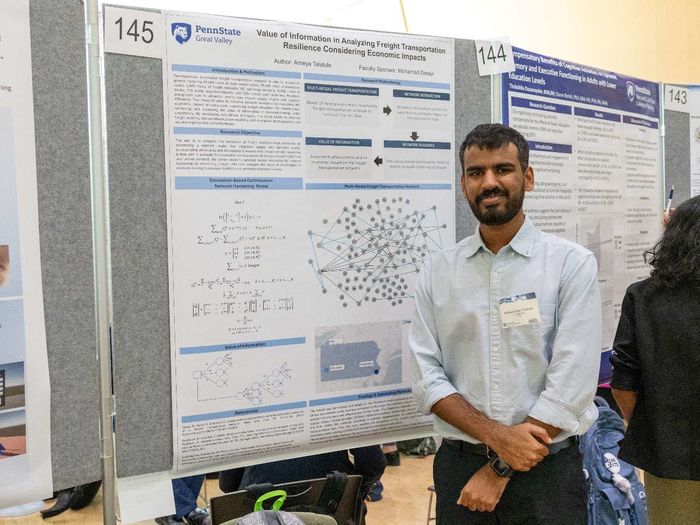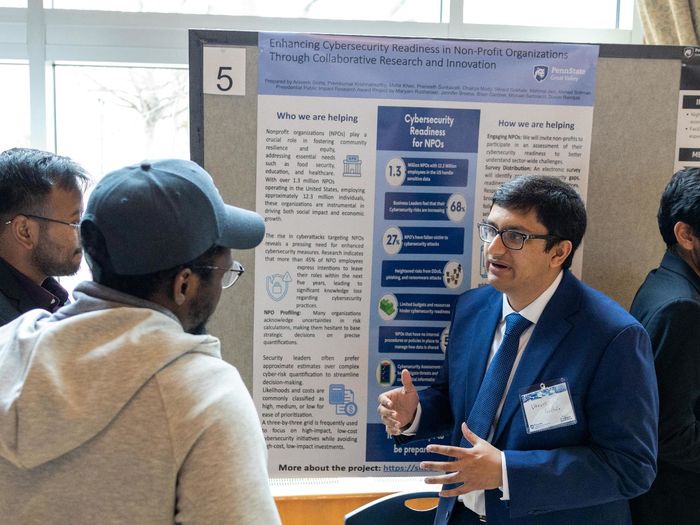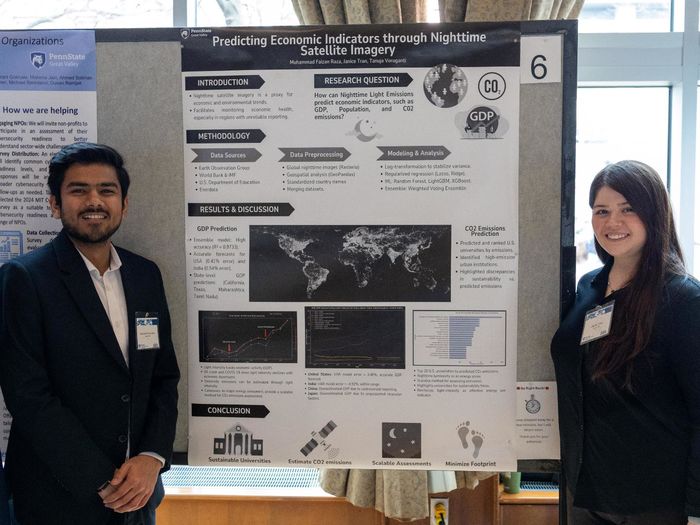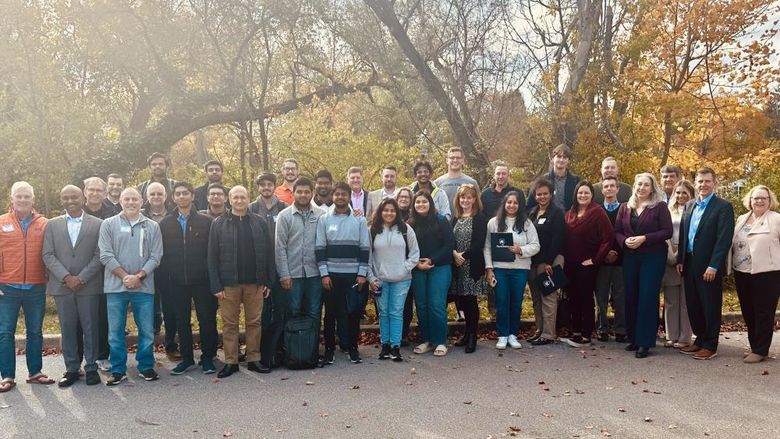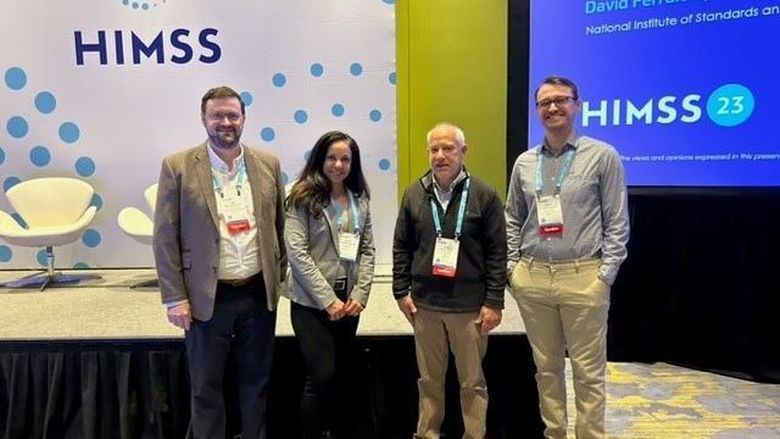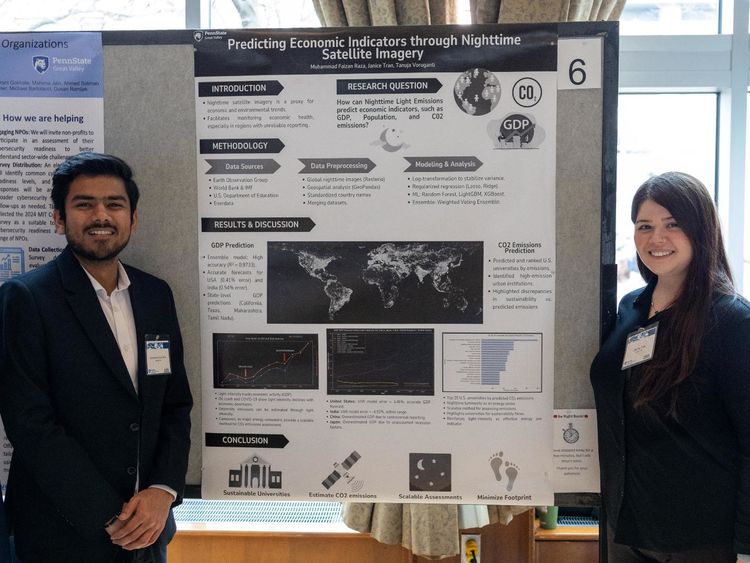
Data analytics students Muhammad Faizan Raza, left, and Janice Tran, right, presented their research on using satellite imagery to collect light data as a tool for monitoring economic development and carbon emissions.
UNIVERSITY PARK, Pa. — Six Penn State Great Valley students presented four research projects at the 2025 Graduate Exhibition, hosted by the J. Jeffrey and Ann Marie Fox Graduate School on March 28 at the University Park campus. The exhibition challenges students to communicate their research and creative scholarship to a general audience in five minutes.
The six Great Valley students who participated used their expertise in various fields — including data analysis, information science and operations optimization — to explore research questions and develop the following projects:
“Value of information in analyzing freight transportation resilience considering economic impacts”
Presented by Ameya Ajay Talatule, master of engineering management student
Project summary: Unexpected disruptions in freight transportation networks can significantly impact supply chains and logistics. This study focuses on enhancing the resilience of Pennsylvania’s multimodal freight transportation network by analyzing economic impacts, identifying important vulnerabilities and optimizing budget distribution for infrastructure improvements.
A network model incorporating supply and demand nodes was developed to assess how disruptions affect capacity and commodity flow. Simulation-based optimization methods were used to identify critical infrastructure investments that minimize financial losses. The results highlight the importance of strategic investment in infrastructure and the role of data-driven decision-making in mitigating risks. By developing a framework for improving freight mobility and infrastructure reliability, this research provides valuable insights for legislators, transportation planners and business executives aiming to strengthen Pennsylvania’s role as a key transportation hub.
Reflecting on his work, Talatule said, “Whether we are aware of it or not, freight transportation affects everyone, from the products we purchase to the way economies react during emergencies. As I began researching the value of information in this area, I became aware of how effective timely and correct information can be in enhancing resilience and averting financial losses. It's thrilling to be a part of a discussion that could lead to the development of more intelligent, responsive systems. … In the end, I hope that this effort will act as a link between research and practical decision-making.”
“Data-driven response to opioid abuse”
Presented by Tanuja Voruganti and co-presented by Muhammad Faizan Raza, master of data analytics students
Project summary: With over 100,000 opioid-related deaths in the U.S. annually, identifying trends and risk factors is critical for developing effective interventions. This study analyzed the geographic distribution of opioid mortality, uncovering emerging hotspots and key socioeconomic drivers of opioid abuse. Utilizing CDC and National Center for Health Statistics datasets, we applied exploratory data analysis, geospatial mapping and predictive modeling to detect regional disparities in opioid dispensing rates and fatalities. We found that New Mexico and Kentucky had consistently high mortality rates. Additionally, the rise of synthetic opioids since 2013 has introduced unpredictable patterns, complicating efforts to forecast opioid-related deaths.
This study also delved into demographic and socioeconomic risk factors for opioid abuse, including economic hardship, inadequate health care access and racial minorities who face barriers to treatment and recovery. This study emphasizes the importance of evidence-based policy decisions, guiding targeted treatment and prevention strategies that can save lives, allocate resources effectively and combat the opioid epidemic with precision and urgency.
“Enhancing the cybersecurity readiness of nonprofit organizations (NPOs) in Pennsylvania”
Presented by Anivesh Sinha, master of science in information science student, and co-presented by Vikrant Gokhale, master of data analytics student
Project summary: Nonprofit organizations play a crucial role in fostering community resilience and equity, addressing essential needs such as food security, education and health care. Nonprofits manage a wealth of sensitive information, including donor details, health records and financial data, making them prime targets for cybercriminals. This research aims to offer actionable guidance that nonprofits can implement within their resource constraints to enhance their cybersecurity preparedness. This research project identifies the top cybersecurity risks nonprofits face and factors influencing these organizations’ cybersecurity readiness. The project summarizes affordable cybersecurity practices that nonprofits with limited resources can adopt, with a focus on employee training. The project also establishes approaches for nonprofits to assess their cybersecurity preparedness and resilience.
Reflecting on the project, Gokhale shared, “If these NPOs choose to take our recommendations, they can take a proactive approach to cybersecurity instead of a reactive one.” He added, “The graduate poster exhibition at University Park was a great experience for me, presenting my work in front of judges. Working on this project with professor Dusan Ramljak has been a great experience so far.”
“Predicting Economic Indicators through Nighttime Satellite Imagery”
Presented by Janice Tran and co-presented by Muhammad Faizan Raza and Tanuja Voruganti, master of data analytics students
Project summary: Nighttime satellite imagery offers a scalable and cost-effective approach to monitoring economic activity, particularly in regions with inconsistent reporting. This study examines the relationship between nighttime light emissions and key economic indicators — GDP, population, and CO2 emissions — by integrating global satellite data with economic datasets from institutions such as the World Bank and the U.S. Department of Education. Through geospatial analysis, data pre-processing, and machine learning techniques, we developed highly accurate predictive models to quantify economic trends. Beyond GDP estimation, we apply this framework to predict CO2 emissions for U.S. universities, identifying discrepancies between institutional sustainability commitments and actual emissions.
This research highlights the potential of nighttime light data as an innovative tool for economic and environmental monitoring, supporting informed decision-making and offering insights for policymakers, researchers and institutions focused on sustainability and economic development.
Tran said that in the course of the research, “I developed new technical skills in geospatial mapping and raster data processing, which opened an entirely new way of analyzing large-scale spatial patterns and trends.”
Tran added that the graduate research exhibition “allowed me to share my passion for the research we conducted and to engage with others who are equally committed to making an impact through their work. … I deeply appreciated the chance to learn about the diversity of research taking place at Penn State and to see how interdisciplinary collaboration can foster new ideas and approaches.”
